The phrase Inspirational Native American Day Stories captures a clear purpose: sharing stories that teach values, connect generations, and inspire action. On American Indian Heritage Day and similar observances, these stories bring history, culture, and moral lessons to life.
In this article you’ll find background, carefully chosen tales, classroom-ready lesson plans, community activity ideas, and guidance on honoring storytellers respectfully.
Why these stories matter?
Inspirational Native American Day Stories are more than folklore — they are living memory. They pass down knowledge about land stewardship, community care, resilience, and leadership. When used thoughtfully in schools, homes, or community events, they help learners build empathy, sense of place, and civic responsibility.
Principles to Guide Selection
- Choose stories shared by Indigenous authors or community programs.
- Avoid sacred or restricted tales unless you have invitation/permission.
- Use contemporary retellings that credit origin communities.
- Pair storytelling with local voices whenever possible.
Inspirational Native American Day Stories
Stories have the power to guide, heal, and inspire. On Native American Day, inspirational tales remind us of resilience, respect for the earth, and the wisdom of generations past. These lessons continue to shine bright today.
1. The Cedar Tree’s Gift
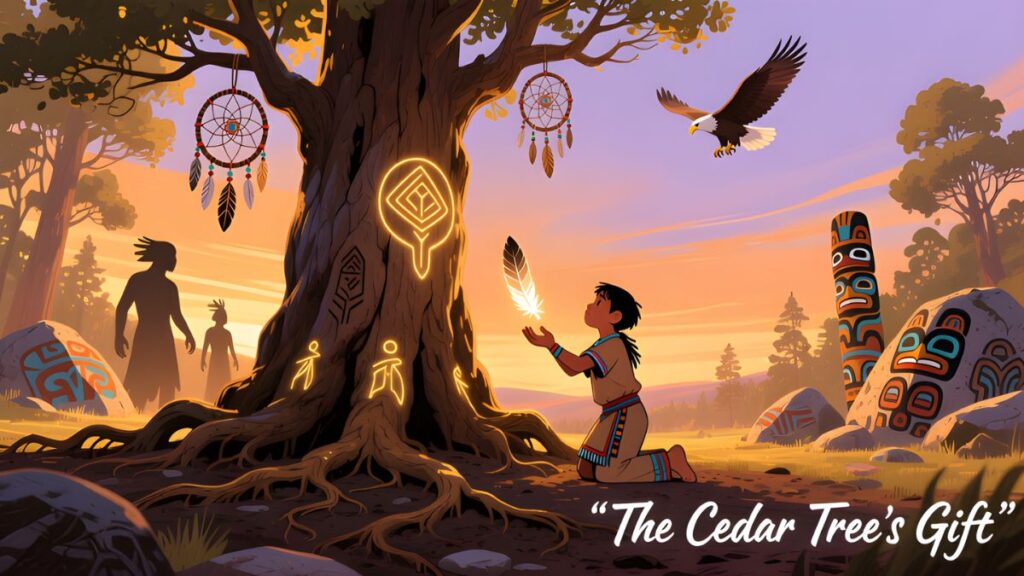
In a small village nestled between rolling hills and dense forests, people lived in harmony with the land.
Their homes were made of wood and stone.
Gardens, rivers, and forests provided food, medicine, and tools.
The villagers honored the seasons with songs, dances, and stories passed down through generations.
Among them was a young girl named Aiyana.
Her name meant “eternal blossom.”
Her spirit was bright like the first days of spring.
Aiyana loved to wander the forest.
She listened to rustling leaves, the calls of birds, and the whispers of the wind.
The elders often said she had a gift.
Aiyana could hear the land speaking.
One winter came harsher than any the village had known.
Snow fell day after day.
The river froze solid.
Food ran low.
Families huddled in their homes, wrapped in layers of blankets.
The wind howled through the trees like a pack of wolves.
The village elders called a council.
“We cannot survive much longer if this cold continues,” one said.
“The children are hungry. The animals are gone. What can we do?”
Aiyana listened quietly.
Her heart ached for her people.
That night, she had a dream.
In her dream, a tall cedar tree stood in the forest.
Its branches were heavy with frost.
The tree spoke softly, its voice rustling like wind through needles.
“Take my branches, young one,” it said.
“Use them to warm your people. I will still stand.”
Aiyana awoke with a start.
Her cheeks were cold, but her mind was alive with the cedar’s words.
She thought of the council, the empty stomachs, and the children shivering.
She knew what she must do.
The next morning, she wrapped herself in her thickest shawl and walked to the forest.
The snow crunched beneath her feet.
She reached the cedar tree from her dream.
It was taller than any tree she had seen.
Its branches stretched gracefully toward the sky.
“Grand cedar,” she whispered, “I heard your message. I will do as you say.”
The branches bent gently, as if nodding in approval.
Aiyana carefully cut a few small branches.
She made sure not to harm the tree.
The cedar’s scent filled her nose—fresh, sharp, and comforting.
She carried the branches back to the village.
Villagers were curious.
“What are these?” they asked.
Aiyana explained the dream.
She placed the branches in the hearths of her home.
That evening, they were burned slowly in the fire.
The smoke filled the rooms with warmth.
Families huddled closer, telling stories and singing songs.
The chill did not vanish completely, but hearts felt lighter.
The next morning, Aiyana returned to the forest.
The cedar tree still stood tall and strong.
She repeated the process every day.
Careful. Respectful. Grateful.
The village watched in wonder.
Children began helping, fetching small branches.
Villagers noticed how a simple act could lift spirits.
The winter stretched on.
Days were long. Nights were dark.
But the village endured.
Aiyana’s courage and the cedar’s generosity reminded the people of community, gratitude, and respect for nature.
One morning, her grandmother called her close.
“Child,” she said, “the cedar has warmed our bodies and hearts.”
“You have learned what the elders always teach. Strength lies in giving.”
Aiyana nodded.
Her heart swelled with purpose.
She realized that her small actions had rippled through the village.
Neighbors shared food. Children helped the elderly.
Even the hunters brought extra meat to families who could not go far.
The village felt united.
Aiyana continued her daily walks to the cedar.
Sometimes she talked to it about her worries.
Sometimes she simply sat beneath its branches, listening.
She noticed how the snow sparkled in the morning sun.
She listened to birds calling above the forest.
The cedar’s presence comforted her.
One night, she had another dream.
The cedar spoke again, softer this time.
“You have given much, young one. But remember, the greatest gift is not the branches, but the care you inspire in others.”
Aiyana awoke, understanding.
She shared the dream with the village.
The elders nodded.
“The cedar teaches us not only to take care of ourselves,” one said, “but to nurture one another.”
From then on, the villagers did more than burn cedar branches.
They helped each other with food, firewood, and medicine.
They shared warmth in their homes and hearts.
Each day, the village became stronger, kinder, and closer.
Spring approached slowly.
Snow melted.
The river ran clear.
The village celebrated with a feast.
Food, songs, and laughter filled the air.
Small cedar branches were placed on every doorway.
They were a reminder of the winter when one girl listened to the forest.
Years passed.
Aiyana grew into an elder.
She told the story to children who came to her home.
“The cedar tree teaches us that even small actions can change the lives of many,” she said.
“Every gift, no matter how simple, carries power when offered with love.”
Children listened wide-eyed.
Some planted trees of their own.
Others tended gardens or helped neighbors.
The story continued to bloom like an eternal blossom in the village.
The cedar tree stood tall, watching over the land.
It was proud of the girl who had listened.
Generations later, parents whispered to children, “Remember the cedar tree. One small act can bring warmth to many.”
The children dreamed of forests, of whispering trees, and of Aiyana, the eternal blossom.
The story became a tradition.
Every winter, branches were placed with care.
Not just to warm homes, but to honor the bond between people and nature.
Every year, the village retold the story.
The gift of courage, kindness, and respect would never fade.
The elders reminded children that listening was just as important as acting.
They said, “A tree may give its branches, but the heart gives the world.”
Aiyana’s tale spread to neighboring villages.
Some elders from other lands came to see the cedar.
They marveled at its strength.
They marveled at how one young girl inspired a whole community.
The story inspired other children.
They learned that listening, patience, and courage could change their world.
Even long after Aiyana was gone, the cedar still stood.
Its branches whispered in the wind.
Its gift endured.
Villagers continued to honor it, teaching their children.
The winter still came, but it was never as frightening.
Because the people remembered Aiyana and the cedar tree.
Because they remembered that a single act of care could warm hearts, homes, and souls.
And the village thrived, generation after generation, in harmony with the forest and the eternal cedar.
Lesson: True strength lies in generosity.
2. The Turtle Who Carried the Stars
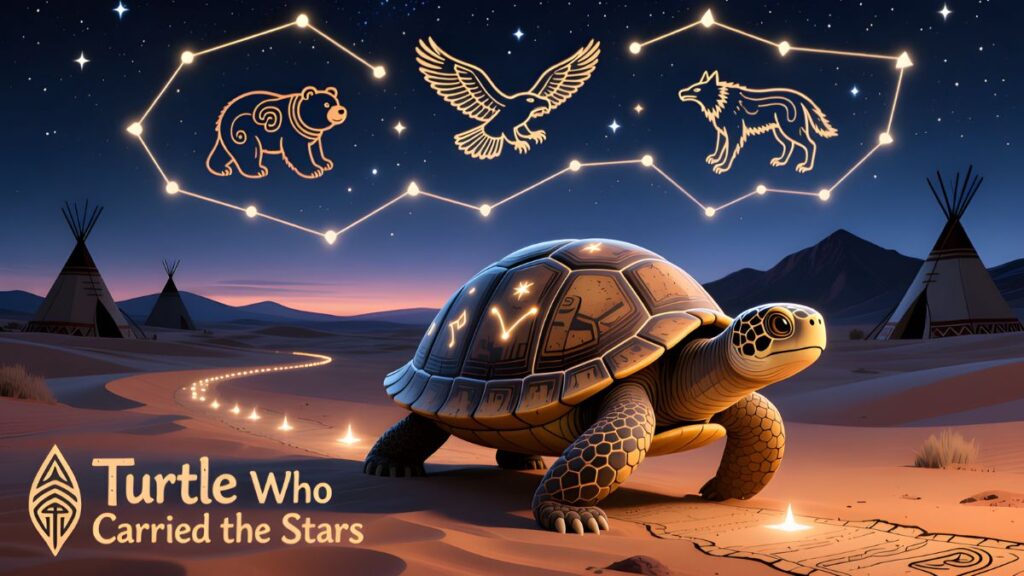
In a quiet village nestled beside a sparkling lake, people lived in harmony with the land and sky.
The lake reflected the mountains and the clouds above.
At night, the sky shimmered with countless stars.
Everyone in the village loved to gaze upward, but few understood the sky as deeply as a boy named Takoda.
His name meant “friend to all.”
Takoda was curious.
He spent hours sitting by the lake, watching the stars twinkle and dance.
He wondered why they never fell.
“How do they stay there?” he asked one evening, his voice barely above a whisper.
The elders smiled but gave no answer.
“Some things are not ours to know,” they said gently.
But Takoda’s mind could not rest.
Night after night, he returned to the lake.
He counted the stars, traced constellations, and imagined journeys among them.
One particularly clear night, the sky seemed brighter than ever.
Takoda lay on the soft grass, eyes wide with wonder.
He felt a presence beside him.
A voice, gentle and deep, spoke from above.
“Why do you wonder, young one?” it asked.
Takoda looked up.
A giant turtle floated across the heavens.
Her shell was wide, glowing with light.
Tiny stars balanced delicately on her back.
“I carry them,” she said, “so you remember that slow and steady care holds the universe together.”
Takoda blinked.
“Why you?” he asked.
“Because someone must,” the turtle replied.
“Balance cannot be rushed. Strength cannot be forced. Care and patience keep the world in motion.”
Takoda felt awe and wonder.
He wanted to ask a thousand questions, but the turtle began to swim slowly across the sky, leaving trails of starlight behind.
“Watch,” she said, “and learn.”
The stars shimmered with gentle rhythm.
Each one moved deliberately, never colliding, never faltering.
Takoda realized that every movement was thoughtful.
Every action had purpose.
The next morning, he awoke in his bed, the memory vivid.
He rushed to the lake and sketched what he had seen in the sky.
The elders saw his drawings.
“This is extraordinary,” one said.
“You have a gift, Takoda. The stars speak to your heart.”
But Takoda did not fully understand yet.
As he grew, he remembered the turtle and her message.
He learned to approach life with patience.
Slowly, deliberately, carefully.
When problems arose in the village, he would pause, breathe, and think.
He considered each option, each ripple of effect.
He remembered how the turtle carried the stars without rushing.
He tried to be like her.
One winter, when the lake froze over, a terrible storm threatened the village.
Winds howled.
Trees bent beneath the weight of snow.
The villagers panicked.
Takoda stepped forward.
He reminded the elders to organize carefully, not frantically.
They reinforced homes, helped the elderly, and gathered food.
Because Takoda approached the crisis with calm, the village endured.
No one was lost.
Years passed.
Takoda became a young man.
He was known for his wisdom, but also for his patience and steady hand.
The villagers often said, “He moves like the turtle in the sky.”
Takoda would smile, remembering the night the turtle taught him about slow and steady care.
One evening, as he walked by the lake, he saw a young girl sitting quietly, staring at the stars.
She reminded him of himself at that age.
He approached and said, “Do you see the stars?”
She nodded.
“Do you wonder why they stay?” he asked.
“Yes,” she said softly.
Takoda smiled.
“Then you have begun your journey,” he said.
He told her the story of the turtle who carries the stars.
The girl listened wide-eyed.
“Patience,” he explained. “Care. Consider every choice.”
“Even the smallest act matters,” he added.
Over time, the village grew stronger.
Villagers treated each other with more care.
They tended the land gently.
They supported one another.
The children learned to move deliberately, like the turtle.
Takoda became a leader, but never hurried.
Decisions were weighed carefully.
He consulted the elders.
He listened to the people.
And he watched the stars every night, reminding himself of the turtle’s lesson.
He taught that life was like the sky.
Even the smallest action could tip the balance if done without care.
Conversely, careful actions could preserve harmony for generations.
One night, many years later, Takoda dreamed again.
The turtle appeared, swimming across the heavens.
“See what you have done,” she said.
“Your patience has spread. Your care has touched many.”
Takoda felt humble.
“I only tried to do what you taught me,” he replied.
The turtle nodded.
“And that is enough,” she said.
Takoda awoke with peace in his heart.
He knew that the stars still moved as they always had.
He also knew that humans, like the turtle, could carry their own small lights carefully.
And that careful care could illuminate entire communities.
From that day, Takoda passed the story to all children in the village.
He reminded them to watch the sky.
To consider their actions.
To move slowly, steadily, and thoughtfully.
And every child who listened remembered the turtle.
They grew to lead with wisdom, to act with patience, and to care for others.
The village thrived for generations.
The lake sparkled.
The forest whispered.
The sky shimmered with countless stars.
And every night, Takoda looked up.
He saw the turtle in his dreams, carrying the stars.
And he knew that slow and steady care would always hold the universe together.
Even long after his own time, children would tell the story.
They would remember patience.
They would remember responsibility.
They would remember the turtle who carried the stars.
The village and the land remained in balance.
People learned that even the smallest acts, done carefully, could shine as brightly as the stars in the night sky.
And the story lived on, guiding generations, like the turtle gliding silently across the heavens.
Lesson: Patience and responsibility keep the world balanced.
3. The Song of the Wind
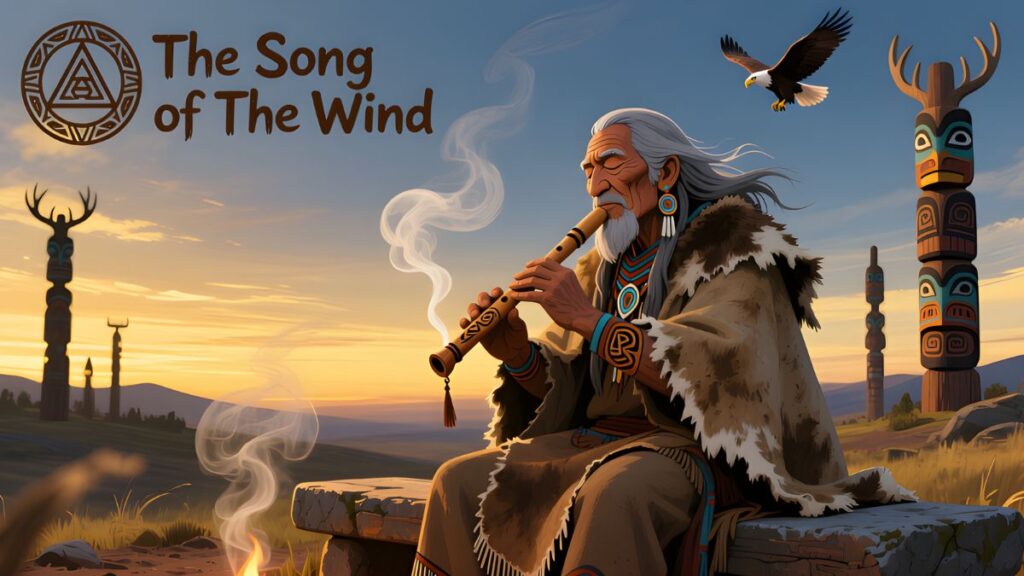
In a village at the edge of wide plains and rolling hills, a young boy named Chenoa lived with his family.
Chenoa loved to run.
From the moment he could walk, he ran.
Through the fields, across the streams, over the hills.
His feet barely touched the ground before he was gone.
He wanted to be the fastest.
The villagers called him “Lightning Foot.”
Chenoa took pride in the name.
But no matter how fast he ran, he always felt something was missing.
He practiced each morning.
Before the sun rose, he sprinted across the dew-covered grass.
He trained through rain, wind, and snow.
The elders watched him.
“Speed alone does not bring balance,” one said.
But Chenoa barely listened.
He only wanted to be the fastest.
One evening, after a long day of training, Chenoa sat by the edge of the forest.
He was frustrated.
No matter how much he tried, he could not surpass his limits.
He panted, his chest heaving, his legs trembling.
The wind picked up.
It whistled through the trees and across the plains.
Chenoa shivered but stayed seated.
And then he heard it.
A soft whisper, carried by the breeze.
“Do not fight me,” the wind said.
“Run with me.”
Chenoa’s eyes widened.
He stood slowly.
“Run with you?” he asked aloud.
The wind curled around him.
It lifted his hair, brushed his cheeks, and seemed to beckon him forward.
Chenoa took a deep breath.
He began to run.
At first, he struggled.
He tried to force himself faster than the wind.
He stumbled.
The wind laughed softly, a sound like leaves rustling in the trees.
“Feel me,” it whispered.
“Breathe with me. Do not fight me. Move with me, not against me.”
Chenoa slowed.
He matched his steps to the rhythm of the wind.
Inhale. Exhale. Step. Step.
The plains stretched endlessly before him.
The wind lifted him gently, carrying him along.
He felt light.
For the first time, running did not feel like a battle.
It felt like a dance.
The sun dipped below the horizon, painting the sky in pinks and oranges.
Chenoa ran until the stars appeared.
He finally stopped.
His chest heaved, but his heart was calm.
He understood.
Speed alone was not enough.
True running was harmony.
Harmony with the land. Harmony with the wind. Harmony with oneself.
The next day, Chenoa returned to his training.
But he trained differently.
He listened to the rhythm of the wind.
He learned the curves of the hills, the dips of the plains.
He ran with awareness.
Not just for speed.
The villagers noticed the change.
Chenoa was faster, yes, but also lighter.
More graceful.
He ran not to beat others, but to move in balance with the world.
Children followed him, eager to learn.
Chenoa taught them to feel the wind.
To listen.
To breathe.
The elders smiled.
“Now you understand,” one said.
Seasons passed.
Chenoa grew stronger, wiser.
He raced during festivals.
But he never forgot the lesson of the wind.
He always moved with care, never against nature.
One winter, a fierce storm swept across the plains.
Snow piled high, and the wind howled.
Many feared to leave their homes.
Chenoa stepped out.
He ran with the wind.
He delivered messages between families.
Guided travelers through the snow.
He helped bring food and supplies where needed.
The villagers were amazed.
Chenoa’s skill was no longer just speed.
It was harmony, wisdom, and service.
Years later, Chenoa became a teacher.
He taught young runners the song of the wind.
He showed them how to listen, how to move with care, and how to find rhythm with nature.
He emphasized patience.
He emphasized observation.
He emphasized connection.
Through him, the village learned a deeper truth: that talent is only powerful when guided by understanding.
The wind became a teacher to all who would listen.
Children would run, feel the breeze, and know the rhythm of the earth.
Chenoa would smile, remembering his first lesson.
A soft whisper in the evening wind.
“Do not fight me. Run with me.”
And every time he ran, he remembered to move not just for speed, but for harmony.
The plains seemed alive with motion.
The grass swayed.
The streams sparkled.
The trees bowed gently.
All moved together in rhythm.
Chenoa felt it in his bones.
He felt the earth beneath him.
The air around him.
The pulse of life in the land.
The villagers came to respect not just his speed, but his wisdom.
He led them through harsh winters, droughts, and storms.
He guided without force.
He moved without arrogance.
He ran with the wind.
And the village prospered.
Even long after Chenoa became an elder, children remembered his lessons.
They ran, listening carefully to the wind.
They learned patience.
They learned balance.
They learned harmony.
And sometimes, on clear nights, Chenoa would lie on the plains.
The wind would brush his face.
He would close his eyes and feel the rhythm.
He remembered the moment it whispered to him.
And he smiled.
The song of the wind lived in the village forever.
It was more than a lesson about running.
It was a lesson about life.
Every step could be guided by care.
Every action could honor the earth.
Every motion could create harmony.
Chenoa had learned the secret of the wind.
And through him, the village learned it too.
The plains, the trees, the lakes, and the sky seemed to dance in quiet agreement.
The song of the wind carried on through generations.
Children ran. Elders guided. The village thrived.
And in every step, the rhythm of harmony lived on.
Lesson: Success comes when we flow with nature, not against it.
4. The River’s Memory
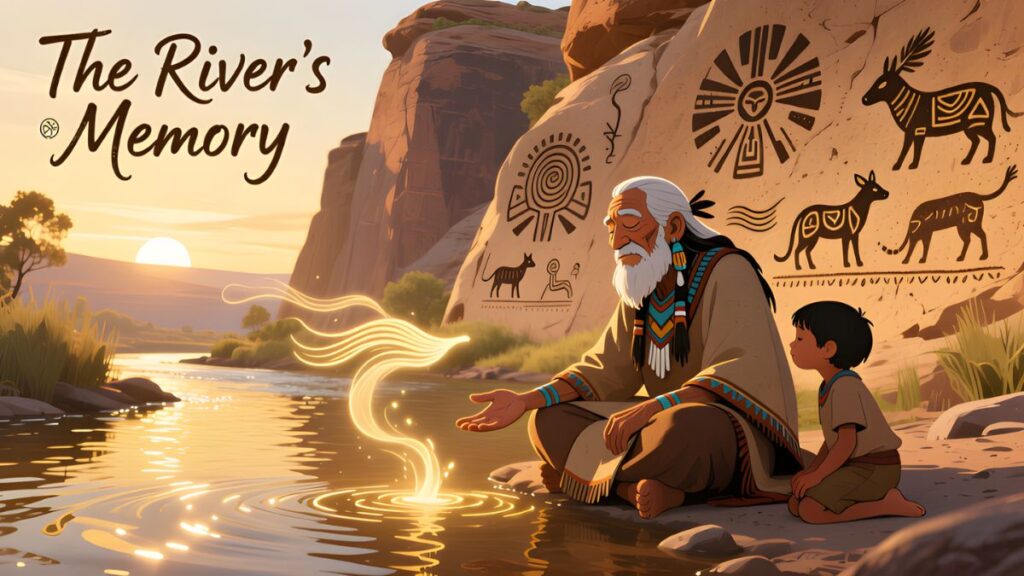
In a village nestled between mountains and a winding river, children often gathered around the elders.
They sat on smooth stones, their feet brushing the soft grass.
The elders shared stories of the land, the animals, and the water.
One story the children loved most was about the river.
“The river remembers,” the elder said, voice calm and steady.
“Every act of kindness, every gift, every prayer—it all stays in its memory.”
The children listened wide-eyed.
They had seen the river swell in spring and shrink in summer.
They had heard its rushing songs and gentle murmurs.
But they never imagined that it could remember like a human.
Among the children was a girl named Nayeli.
Her name meant “I am thankful.”
Nayeli was curious about everything.
She asked endless questions about the river.
“How can a river remember?” she asked one day.
The elder smiled.
“It remembers the care we give it, just as it carries water to sustain life. Even the smallest gift counts.”
Nayeli’s eyes sparkled.
She decided to test the river’s memory.
The next morning, she plucked a bright yellow flower from her mother’s garden.
She walked to the riverbank.
She dipped the flower in the water.
“Thank you,” she whispered softly.
The river rippled as if acknowledging her words.
Every morning, Nayeli returned.
A flower, a leaf, a small pebble—anything she could give.
Sometimes she spoke to the river.
Sometimes she simply watched the water flow.
The other children laughed at her.
“You waste your time!” they said.
But Nayeli ignored them.
She believed in the river’s memory.
Seasons passed.
The flowers changed with the weather.
Snow fell and melted.
The river swelled with rain and shrank in dry months.
Nayeli continued her ritual.
Her small gifts were unnoticed by most adults.
But she knew the river remembered.
Years later, the village faced a terrible threat.
The rains came heavy and unending.
The river rose.
Its waters churned angrily.
Villagers ran to reinforce their homes.
Sandbags were piled along the banks.
Boats were ready to carry the elderly and children to safety.
Fear was everywhere.
Nayeli, now older, stood by the river.
She had given flowers, leaves, and pebbles for many years.
She whispered, “Please, remember kindness. Help us now.”
That night, a miracle happened.
The river, swollen with rain, approached the village.
It roared and surged.
But when it reached the edge of the homes, it curved.
Its waters found a different path.
The village was spared.
The villagers could not believe their eyes.
“How?” they asked.
The elder smiled knowingly.
“The river remembered,” he said.
“It remembered every gift, every act of care offered over the years.”
Nayeli knelt by the water, tears streaming.
She touched the river gently.
“Thank you,” she whispered.
From that day, the village treated the river differently.
No one took water or resources for granted.
Children were taught to care for the river, to speak kindly to it, and to offer gifts.
They placed flowers, leaves, and small pebbles along the banks.
They sang songs of gratitude.
The river flowed calmly, as if acknowledging their respect.
Nayeli grew into a wise woman.
She shared the story of the river with new generations.
“Even small acts matter,” she told the children.
“The river remembers every kindness. And it will protect those who care.”
Many years later, when Nayeli was very old, the river flooded again.
The villagers prepared, but they were not afraid.
They had learned to live in harmony with the river.
They offered gifts, sang songs, and respected its power.
The waters curved, just as before, sparing homes and fields.
And the children learned a lasting lesson:
Kindness is never wasted.
Every gift, no matter how small, is remembered.
Even by the river.
The village thrived.
The river flowed.
And every spring, flowers were placed along the banks in memory of Nayeli’s devotion.
The story became a tradition.
Parents told children as they walked by the water:
“Remember, the river has memory. Be kind, and it will remember you.”
Even long after Nayeli was gone, the river continued to carry the gifts of gratitude.
And villagers, inspired by her example, lived with care for the land and water.
The river remembered.
It always remembered.
And in its memory, the village found safety, harmony, and lasting peace.
Lesson: Acts of kindness ripple far beyond what we see.
5. The Bear Who Shared His Strength
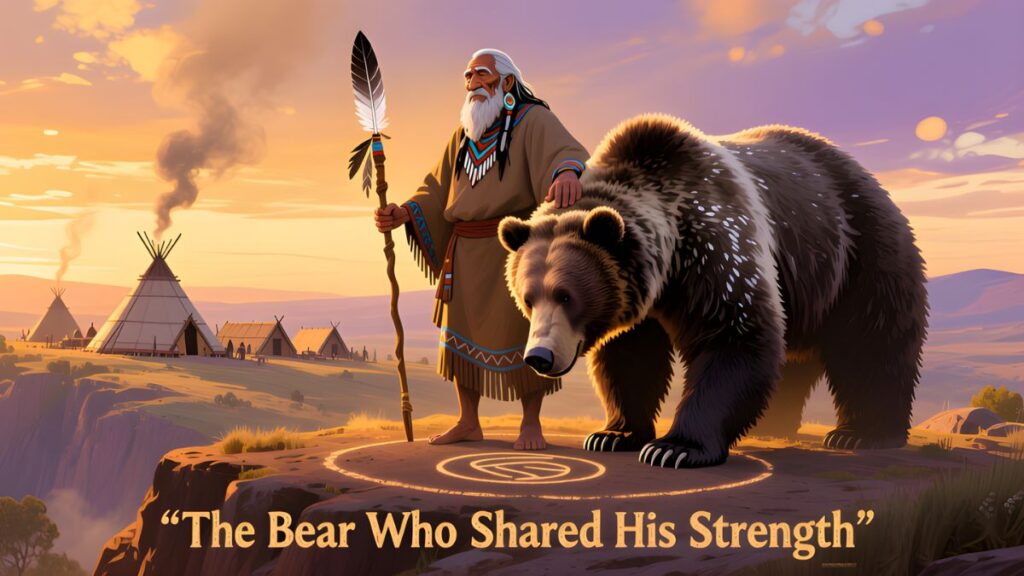
In the heart of a dense forest, there lived a great bear named Mato.
Mato was proud and strong.
His fur was dark as the night.
His claws could tear trees from the ground.
And his roar could be heard across valleys and streams.
The other animals feared him.
Deer froze when he approached.
Foxes hid in the underbrush.
Even the birds would stop singing when Mato passed.
He liked it that way.
The bear enjoyed his power.
He enjoyed the way the forest seemed to bow before him.
But Mato was also lonely.
Despite his strength, he had no friends.
Other animals avoided him.
He had no one to share the forest with.
One hot summer, the forest grew dry.
Rivers shrank to trickles.
The sun scorched the earth.
The birds flew higher to escape the heat.
The deer grazed in patches of shade.
Mato wandered through the trees, roaring loudly.
He hoped to hear an echo.
It gave him comfort, even if no one else responded.
Then, one afternoon, smoke appeared on the horizon.
A fire swept through the dry forest.
Flames leapt from tree to tree.
Animals screamed in panic.
Birds flapped frantically.
Deer ran blindly.
Mato watched for a moment, feeling the heat on his fur.
Something stirred inside him.
He realized that all the animals in the forest were in danger.
The fire could destroy everything.
Mato’s roar, once a tool of fear, seemed small against the roaring flames.
He remembered the river and the lake nearby.
If he could reach it, perhaps he could help.
With great effort, Mato ran to the lake.
He scooped water in his massive paws.
He carried it back to the burning forest.
He poured water over trees and animals, putting out small flames.
The animals stopped and watched.
They could not believe what they saw.
The bear, who had terrified them for years, was saving their lives.
One by one, the animals joined him.
The deer carried buckets of water.
The foxes guided smaller animals to safety.
Even the birds dipped their wings into streams, sprinkling water over the flames.
Together, they fought the fire.
Hours passed.
The sun began to set.
The fire finally dwindled.
The forest was scorched, but the animals survived.
Mato stood in the clearing, panting.
He looked around at the animals.
Their eyes were wide with awe.
They no longer saw fear in him.
They saw strength, courage, and care.
From that day on, Mato’s roar changed.
It was no longer to frighten others.
It became a call.
A call for unity.
Whenever danger threatened, Mato would roar.
The animals would gather.
Together, they would solve problems.
Together, they would protect their home.
Mato discovered something even greater than strength.
He discovered friendship.
He discovered trust.
He discovered that sharing his gifts could bring joy and safety.
Seasons passed.
The forest grew green again.
New trees sprouted where the fire had passed.
The river flowed, clear and calm.
Mato wandered through the forest, his roar echoing not with fear, but with purpose.
Animals approached him without fear.
The deer grazed nearby.
Foxes played in the underbrush.
Birds sang from the trees.
Even the smallest creatures came closer.
Mato felt warmth in his heart.
He realized that true strength is not about dominance.
It is about helping others.
One evening, Mato gathered all the animals in a clearing.
He told them, in his way, that together they were stronger than any fire or storm.
The animals listened.
They nodded, even if they did not fully understand his words.
From that day forward, the forest thrived.
The animals worked together.
They shared food, guided one another, and protected their home.
Mato was no longer lonely.
He had friends.
He had a family.
And his roar reminded everyone that unity and cooperation were more powerful than fear.
Years later, young animals would gather near Mato.
They would ask him about the fire.
He would demonstrate how to carry water, how to work together, and how to use strength wisely.
The story of the bear who shared his strength spread through the forest.
Animals in neighboring woods came to learn.
They saw that courage and care could change a community.
Even long after Mato grew old, his lesson remained.
Roars were heard, not as threats, but as calls to gather, to help, to protect.
The forest lived in harmony.
Strength was measured not by fear, but by generosity.
Mato, the once-feared bear, became the heart of the forest.
And every creature, big and small, remembered that true power is in sharing and caring.
Lesson: True power brings people together.
6. The Talking Corn
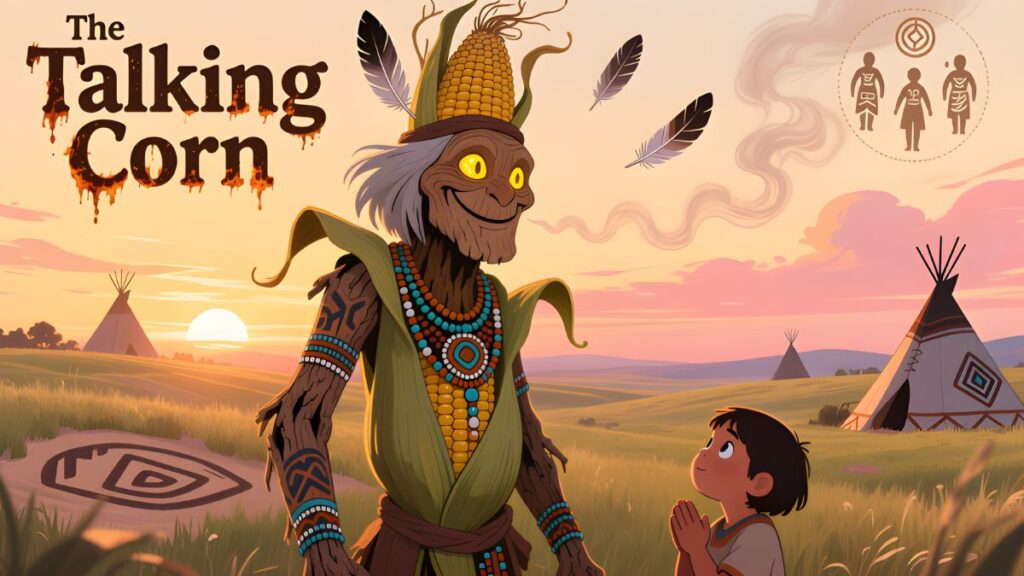
In a village surrounded by rolling fields and gentle hills, people worked hard to feed their families.
The soil was fertile, but some years were difficult.
Droughts or pests would take their toll.
One summer, the village faced a particularly hungry season.
The crops struggled to grow.
Food became scarce.
Children went to bed hungry.
The elders worried.
Everyone whispered about how to survive the season.
Among the villagers was a young boy named Kaya.
His name meant “wise child.”
Kaya was curious and brave.
He often wandered the fields and forests, observing plants, animals, and the sky.
He paid attention to every detail.
One night, after a long day walking through the fields, Kaya fell into a deep sleep.
He dreamed of three sisters.
They were radiant, glowing in colors of gold, green, and orange.
Corn, Beans, and Squash.
The tallest, Corn, spoke first.
“Plant us together,” she said softly.
“And we will feed you.”
Kaya listened carefully.
Beans spoke next.
“We will give strength to the soil.”
“Roots intertwined,” she said.
Squash added, “We will cover the ground, protect each other, and nourish your people.”
Kaya awoke at sunrise, heart racing.
He remembered the dream vividly.
He ran to his parents.
“I dreamed of three sisters,” he said.
“They will feed us if we plant them together.”
His parents listened carefully.
They had heard many dreams, but something in Kaya’s eyes made them believe him.
The elders were called together.
Kaya shared the dream with them.
Some laughed.
Others were skeptical.
But a few nodded thoughtfully.
“The boy has a gift,” one elder said.
“If the dream guides us, perhaps we should try.”
The villagers agreed.
They prepared a new field together.
Corn seeds were planted tall and straight.
Beans were planted near the corn, ready to climb and support.
Squash was placed around the edges, its leaves wide and protective.
Every villager helped.
Even children carried small seeds carefully in their hands.
Weeks passed.
The sun rose and set.
Rain fell gently.
The Three Sisters grew.
Corn stretched toward the sky.
Beans wrapped around the corn, climbing steadily.
Squash spread its leaves, shading the soil.
Kaya watched each day.
He learned patience, observing how the plants grew together.
Other villagers noticed the difference.
The crops were stronger than ever before.
When harvest time came, the village celebrated.
They gathered corn, beans, and squash in abundance.
There was more food than they had hoped.
No one went hungry that year.
The villagers honored the crops as family.
They remembered the dream that had guided them.
Every planting season after, the village continued the tradition.
The Three Sisters garden became central to their lives.
Children learned to plant carefully, tending the crops with respect.
The elders told the story of Kaya’s dream and the sisters who spoke.
“Plant together,” they said, “and the earth will provide.”
Kaya grew older.
He continued to walk the fields, teaching the younger generations.
He told them to listen to the land and to care for it.
“Nature speaks to those who pay attention,” he said.
Years passed, and the village thrived.
The Three Sisters garden fed them each season.
The people were healthy and strong.
The crops became part of their ceremonies and festivals.
They offered thanks to Corn, Beans, and Squash before each harvest.
And the children learned that food was a gift, not just a necessity.
One day, a neighboring village heard of the story.
They came to learn about the Three Sisters garden.
They planted their own fields together, and soon, they too prospered.
The knowledge spread, carried by travelers, hunters, and storytellers.
The lesson was clear: when people work with nature, with respect and care, the land will provide.
Kaya’s dream had shown them the way.
Even long after Kaya grew old and the dream became legend, the village continued the practice.
Corn, Beans, and Squash were planted together every year.
Children would plant seeds with joy.
Elders would share wisdom.
The harvests were plentiful.
Families were nourished.
And the people never forgot the sisters who had spoken in a dream.
They learned that listening, caring, and planting together were as important as any labor.
The land was alive with gratitude.
The crops flourished.
And the village thrived.
The story of the Talking Corn became a tradition.
Parents told children as they worked in the fields:
“Remember the Three Sisters. Work together, care for each other, and the earth will care for you.”
The people honored the crops, the dream, and the wisdom of the earth.
Even in difficult seasons, they remembered: the sisters would provide if they were planted with care and respect.
The village grew strong, guided by the harmony between humans and the land.
And the legacy of Kaya’s dream lived on, generation after generation.
Lesson: Cooperation and balance create abundance.
7. The Sky Dancer
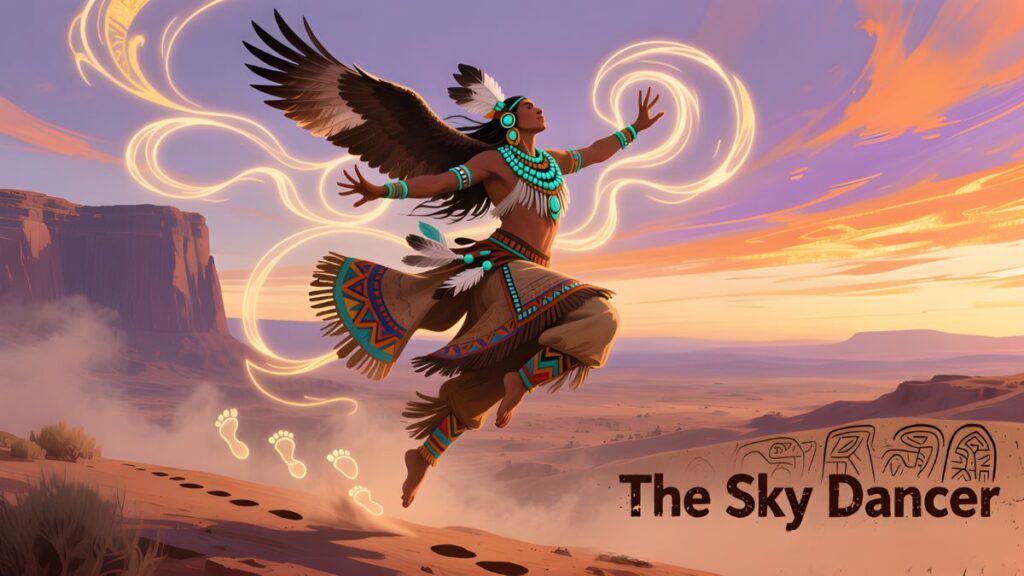
In a quiet village at the edge of the plains, a young girl named Aponi lived with her family.
Her name meant “butterfly.”
Aponi was full of energy and curiosity.
She loved music, movement, and the open sky.
From the moment she could walk, she twirled and leaped wherever she went.
The village children watched her, sometimes laughing.
“You dance like the wind is carrying you away!” they teased.
Even adults shook their heads.
“Why waste time dancing when there is work to do?” they said.
But Aponi did not mind.
She felt joy in movement.
She felt alive beneath the sun, the moon, and the stars.
One evening, as the sky turned deep indigo and stars began to appear, Aponi stepped into the village clearing.
She danced slowly at first, feeling the cool night air.
Then she twirled, spun, and leaped higher and higher.
The stars above seemed to shine brighter.
They glittered as if keeping rhythm with her steps.
The wind whispered through the trees.
It brushed her cheeks and lifted her hair.
Aponi laughed with delight.
The villagers peeked from their homes.
Some shook their heads.
Some whispered, “She is foolish.”
But others stopped to watch.
Something about her joy was contagious.
The stars flickered and shimmered, reflecting her movements.
Aponi danced for hours, not caring who watched.
She felt a connection with the sky, the earth, and the air around her.
That night, she dreamt.
In her dream, the stars descended closer to earth.
They spun, twirled, and shimmered alongside her.
They whispered, “Your joy is a gift. Share it. Let it spread.”
Aponi awoke with a smile.
She remembered the dream vividly.
The next evening, she returned to the clearing.
She danced again.
This time, a few children gathered to watch.
They hesitated at first.
Then, slowly, they joined her.
They twirled, leaped, and laughed.
Their movements were awkward at first, but joy flowed through them.
The village elders noticed.
They frowned, then smiled quietly.
“Perhaps there is something in this joy,” one said.
Each night, more villagers came to watch Aponi dance beneath the stars.
Some joined in.
They moved together in harmony.
The rhythm of laughter and movement spread throughout the village.
Soon, what began as Aponi’s solitary dance became a celebration.
The clearing became a place of gathering.
Music was played.
Songs were sung.
Dances grew longer, more elaborate.
Aponi guided the younger children, teaching them steps, spins, and how to feel the rhythm of the wind.
Through the seasons, the dance became a tradition.
At the first stars of spring, villagers would gather in the clearing.
They danced together, honoring joy, community, and courage.
Even elders participated, moving slowly with laughter and grace.
Aponi became a teacher, sharing the joy of movement.
She reminded everyone that dancing was not just play.
It was celebration.
It was connection.
It was courage.
Because she had dared to dance alone, she had shown others the beauty of being oneself.
Over the years, travelers came to the village.
They marveled at the tradition.
They asked why the people danced beneath the stars.
The villagers shared the story of Aponi.
“How one girl followed her heart,” they said.
“And how her joy spread to all.”
Even when Aponi grew older, she continued to dance.
She no longer twirled as high as before, but her movements were filled with grace and wisdom.
Children ran to join her, eager to learn.
She told them, “Do not fear being different. Do not fear joy. Share it, and it will grow.”
The stars seemed to shine brighter each night the village danced.
Sometimes, it felt as if the sky itself joined in.
The villagers laughed, leaped, and spun under the sparkling heavens.
The clearing was filled with music, footsteps, and the light of the stars.
Even in hard times, the dance reminded the people of joy and courage.
When winter came, the village would gather in the main hall, but they still danced, lifting spirits and hearts.
Spring and summer brought them back to the clearing.
The tradition endured.
Through generations, children learned the story of Aponi.
They learned that courage means being oneself.
They learned that joy, when shared, can unite a community.
They learned to honor the sky, the earth, and each other.
The village thrived, not only in harvest and health but in spirit.
Every starry night, children twirled in the clearing.
Adults joined.
Elders smiled.
And somewhere in the middle of it all, Aponi danced, her spirit forever young.
The story spread beyond the village.
Neighboring communities came to witness the Sky Dance.
They learned that joy and courage are contagious.
They returned to their homes, carrying the lesson of dancing beneath the stars.
Even long after Aponi was gone, the village continued the tradition.
The clearing became a sacred place.
The night sky seemed to sparkle in recognition.
And every child who danced remembered her courage.
They remembered that being oneself, even when laughed at, can inspire generations.
The Sky Dancer had shown them that joy, shared freely, can light the world.
Through her story, the village learned that courage, joy, and connection are gifts as enduring as the stars themselves.
And every night, when the stars shimmered above, the people danced.
They twirled, leaped, and laughed.
They remembered Aponi, the girl who dared to dance beneath the sky.
And the tradition continued, bright, joyful, and alive, generation after generation.
Lesson: Joy and courage can inspire a whole community.
Classroom & Community Activities
Grades K–5 (simple, tactile)
- Read-aloud + retell: short retelling followed by paired retell.
- Art link: illustrate a scene or symbol.
- Mini-service: class “small action” project (helping a neighbor, seed-planting).
Grades 6–12 (inquiry & action)
- Research origin: students investigate story authorship and place.
- Debate & reflection: what choices could change outcomes?
- Project-based: modern retelling connected to a local community action.
Family & community
- Story swap nights where relatives share memory or family tales.
- Nature walks to link story elements with local plants and animals.
- Community story circles hosted in partnership with local cultural centers.
Sample One-week Unit (grades 3–5): Ready to Adapt
Day 1: Land acknowledgment & read-aloud (15–25 min)
- Offer a brief, sincere land acknowledgment. Read Hummingbird and the Fire. Ask: “What small thing can you do this week to help someone?”
Day 2: Vocabulary & storyboard (40 min)
- Teach key words; students produce a three-frame storyboard.
Day 3: Guest connection (40–60 min)
- Host a storyteller/cultural educator and compensate them fairly.
Day 4: Art & planning (45 min)
- Create art tied to the tale and plan a small service project.
Day 5: Presentation & reflection (30–45 min)
- Students present, share an “I will…” pledge, and close with a reflective circle.
Assessment ideas: storytelling rubric, reflection journals, and community feedback.
Teaching With respect: ethics & best practices
- Attribution: always name the storyteller or community when known.
- Avoid appropriation: do not perform sacred rituals or present restricted content.
- Consent & compensation: invite local partners and pay honoraria.
- Use primary sources: favor books and resources by Native authors and tribal programs.
Cultural sensitivity checklist (quick)
- Did we consult local tribal cultural centers?
- Are storytellers fairly compensated?
- Have we confirmed story permissions?
- Do classroom materials credit origin communities?
Storytelling Techniques that Work
- Call-and-response for young children.
- Use of approved music (rhythms, clapping) to support memory.
- Minimal props and strong contextual framing.
- Pause for reflection: ask open-ended questions to deepen understanding.
FAQs
What are some Inspirational Native American Day Stories for kids?
Short, age-appropriate retellings like Hummingbird and the Fire, The River’s Promise, and Eagle Feather and the Oath work well. Prioritize books by Native authors.
Can Inspirational Native American Day Stories be used in multicultural celebrations?
Yes, when presented with cultural accuracy, permission, and context to avoid tokenism.
Where can I find authentic stories and storytellers?
Contact tribal cultural centers, university Native studies programs, local libraries, and reputable museum education portals like the Smithsonian’s resources.
Are there copyright concerns when retelling traditional stories?
Some traditional stories are public domain; others are controlled by communities. Always check permissions or choose contemporary retellings by Native authors.
Quick checklist before presenting a story
- Source verified and appropriate for the audience.
- Permission obtained for restricted content.
- Storyteller or community credited and honored.
- Activity connects back to learning outcomes and community needs.
Conclusion
Inspirational Native American Day Stories connect readers to values, place, and community. Used thoughtfully, these tales teach empathy, stewardship, and civic responsibility.
Center Indigenous voices, credit storytellers, and choose stories with care. Start small — choose one short Inspirational Native American Day Stories, reach out to a local cultural center, and plan a story circle. By doing so, you honor both the tale and the people who keep it alive.
Call to action: Pick one Inspirational Native American Day Stories this month, invite a local storyteller, or begin a classroom story circle. Small steps lead to lasting relationships.




